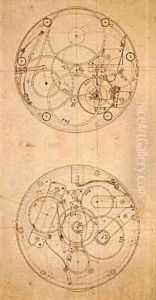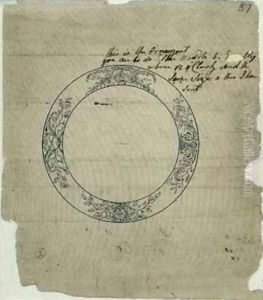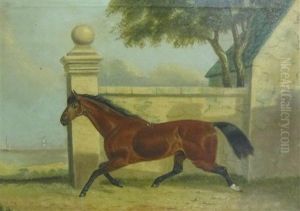John Harrison Paintings
John Harrison, though not primarily known as an artist in the traditional sense of painting or sculpture, made an indelible mark in the realm of horology, which is the art and science of measuring time. Born in Foulby, Yorkshire, England, in 1693, Harrison was a self-educated carpenter and clockmaker who rose to prominence through his invention of the marine chronometer, a device crucial to navigation at sea. His work represents a unique blend of artistic craftsmanship and scientific innovation, showcasing his profound understanding of materials and mechanics.
Harrison's journey began in the early 18th century, a time when finding a ship's precise longitude at sea was one of the most pressing scientific challenges. The inability to determine longitude accurately led to numerous naval disasters and was a significant obstacle to global exploration and trade. In 1714, the British government established the Longitude Act, which offered a substantial monetary reward for anyone who could find a practical solution for determining a ship's longitude at sea.
Motivated by this challenge, Harrison devoted his life to the creation of an accurate marine timekeeper, a quest that would span several decades. His first major contribution was the H1, a large sea clock that proved successful in initial tests but was deemed too bulky for practical use. Undeterred, Harrison continued refining his designs, leading to the creation of H2 and H3, each an improvement over its predecessor but still not the perfect solution Harrison sought.
It was not until the development of H4, a much smaller, watch-sized device, that Harrison achieved his breakthrough. The H4's successful trials, including a voyage to Jamaica in 1761-62, demonstrated its remarkable accuracy in determining longitude, effectively solving the problem that had vexed sailors for centuries. Despite this success, Harrison faced bureaucratic hurdles and skepticism from the Board of Longitude and did not receive the full reward until influential supporters, including King George III, intervened on his behalf.
Harrison's contributions extended beyond the marine chronometer. He also made significant advances in clockmaking, including innovations in escapements, the use of bimetallic strips to compensate for temperature fluctuations, and the invention of the gridiron pendulum. These innovations had a lasting impact on the field of horology, improving the accuracy of timekeeping devices on land and at sea.
John Harrison passed away in 1776 in London, leaving a legacy not only as a pivotal figure in the history of navigation but also as a testament to the interplay between art, craftsmanship, and science. His life's work underscores the importance of perseverance, innovation, and interdisciplinary approaches to solving complex problems. Harrison's story is celebrated in literature, film, and exhibitions, ensuring that his contributions to horology and his unique role as an artist of time are remembered and appreciated.


